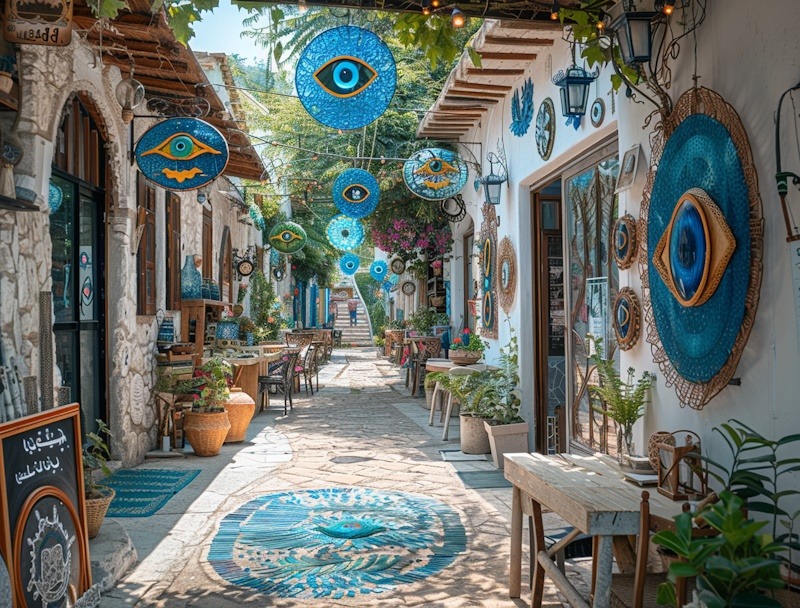
The evil eye is not just an ordinary symbol. People in many different cultures around the world believe it has immense power. A crucial part of this belief is that certain looks – usually powered by jealousy or mean intentions – could bring about trouble. This might look like bad luck occurring unexpectedly or even challenges with health and prosperity. Since time immemorial, people have truly thought that these harmful stares can change one’s life negatively. The interesting thing about the evil eye is its universal presence across borders. Different religions, too, have views on this eerie concept! As we move further into our article here, we will talk more broadly about what exactly the ‘evil eye‘ stands for, where it originated from as a term – is it really harmful? We’ll also dash into how to rid oneself of its adverse effects effectively and share some trusted ways you can protect yourself against such unseen harm!
What’s the Meaning of the Evil Eye?
The evil eye is mainly known as a hex that can be passed on by just one look, mostly powered by jealousy. This “hex” might lead to unfortunate events, sickness, or assorted negative occurrences for those who are targeted. The effect of the evil eye could carry bad intentions or might happen entirely by accident – when someone looks at another with envy or positive-less appreciation.
Across various cultures, folks tend to be extra careful about not being too noticeable or envied out of fear that they might unintentionally attract the evil eye. Compliments in this context may carry unexpected negative vibes. In many parts around the globe, it’s usual to see people taking precautions whenever someone shows admiration towards a youngster, house, or any valuable thing – under the impression that such praise could invite unpleasant events.
Interpretations Across Cultures
Middle East and North Africa: In Arabic-speaking countries, the evil eye is called “Ayn al-Hasud” (the envious eye). This belief is so strong that phrases like “Masha’Allah” (God has willed it) are commonly added after compliments to neutralize harmful energy.
Greece and Turkey: The evil eye, called “μάτι” (mati) in Greek and “Nazar” in Turkish, is particularly feared. People often wear blue evil eye amulets (Nazar Boncuk) to ward off its bad effects.
Latin America: Known as “mal de ojo,” the evil eye is often feared in many Hispanic cultures. In some regions, babies and young children are considered particularly vulnerable, and protective measures are commonly taken to protect them from its effects.
In all these traditions, the evil eye represents more than bad luck—it reflects the deeply ingrained belief that envy and negativity can physically, mentally, or spiritually harm another person.
Where Does the Evil Eye Come From?
The evil eye concept, one of the oldest beliefs in human history, spans continents and cultures. It suggests that people from many different societies have shared a common concern: the harmful effects of envy. Going back in time, we follow the pathway to when people first started creating communities. This journey spotlights how crucial it was even then.
Ancient Civilizations
One of our first hints at this belief in an “evil eye ” came from ancient Mesopotamia, around 3000 BC. We’ve found things like charms shaped like eyes and art with images of eyes. People probably used them to protect themselves from evil glances.
The Greeks and Romans strongly considered the power behind an evil gaze. Greek thinker Plutarch wrote extensively about how harm can come from someone else’s jealousy. In Rome, eye-like designs were commonly featured in public places long ago to protect against people with envious or nasty thoughts.
In ancient Egypt, the Eye of Horus was a potent symbol of protection, often used to counter the negative effects of the evil eye. Egyptians believed certain individuals, particularly those with strong spiritual or psychic abilities, could cast harmful energy through their eyes.
Spread Across Cultures
As civilizations grew and intermingled through trade, warfare, and exploration, the belief in the evil eye spread to other parts of the world. From the Mediterranean to the Middle East, from Africa to South Asia, each culture demonstrated the resilience of its spiritual frameworks by adapting the idea of the evil eye. Despite these regional variations, one constant remains: the evil eye symbolizes harm caused by envy or ill intent, and protection from it is essential.
Today, the evil eye remains a global phenomenon, a testament to the rich tapestry of religious and cultural practices worldwide.
Is the Evil Eye a good or bad?
Most would, understandably, jump straight to “bad.” Many traditions say it’s not great since it comes from envy or jealousy – messy emotions we’ve all had before! But hang on! It’s not as straightforward as you might think. Some look at the Evil Eye differently – they see shades of gray, whereas others only see black and white. Besides being a curse (not very friendly), there can be more to the story, like some supernatural understanding or protection, depending on what’s happening.
